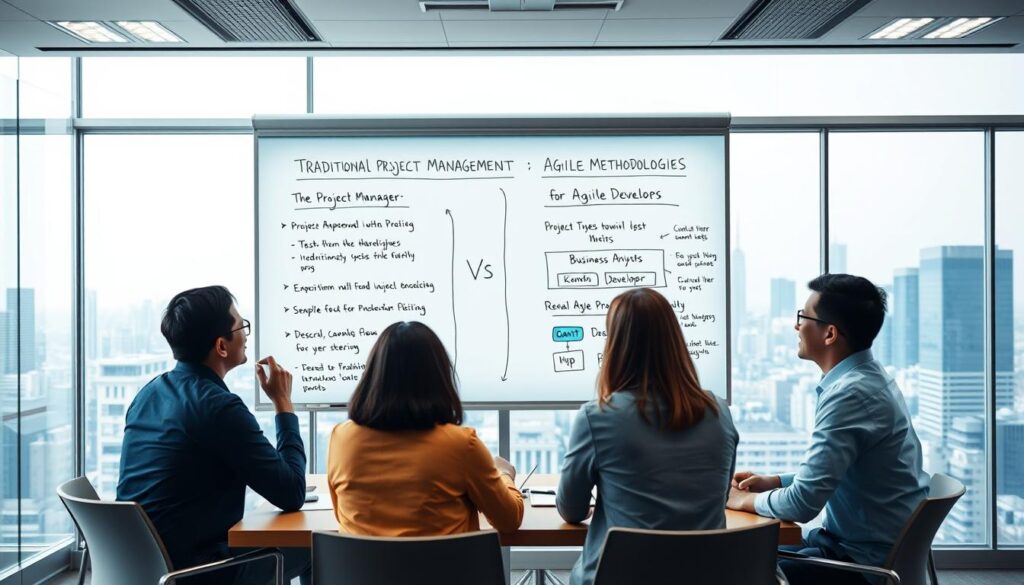Have you ever thought about how combining structured planning with flexible strategies could change AI project management? In today’s complex world, mixing traditional and agile methods might be the answer. This approach is crucial in Southeast Asia, where success is everything.
By blending these methods, project managers can use the best of both worlds. This helps them overcome the challenges of AI projects. Let’s dive into how this combination can make AI projects more successful.
Key Takeaways
- Combining traditional project management with agile methods can improve adaptability.
- Understanding the strengths and weaknesses of both approaches is crucial.
- Hybrid project management can lead to better outcomes in complex AI projects.
- The Southeast Asian market presents unique challenges that benefit from this blending.
- Effective communication is key to successfully implementing a hybrid framework.
Understanding Project Management Methodologies
Project management methodologies guide teams to reach their goals well. The choice of method affects planning, execution, and delivery. Traditional and agile methods are two main approaches, each suited for different projects.
Overview of Traditional Project Management
Traditional Project Management uses the Waterfall method, known for its structured way. It breaks projects into phases that follow each other. Each phase must finish before starting the next, making it good for projects with clear goals.
Industries with strict rules or limited changes often use this method. It ensures projects stick to the original plan and timeline.
Key Characteristics of Agile Methodologies
Agile methodologies focus on flexibility and teamwork. They allow for quick changes and feedback. This helps teams improve continuously.
This method is great for fast-changing fields like software development. Agile lets teams give small results first. This way, the final product meets user needs well.

The Rise of Hybrid Project Management
Hybrid project management is becoming more popular. It mixes traditional and Agile methods. This way, teams can handle today’s complex projects better.
In the Philippines, companies are using this method a lot. It helps them work well in uncertain times. The mix of structure and flexibility makes projects more successful. It also helps teams work together better, which is key for new ideas.

Benefits of Combining Traditional and Agile Approaches
Mixing traditional and Agile methods has many benefits for teams. It creates a balance that boosts efficiency and quickness in different projects. This mix is key to success in various project settings.
Flexibility Meets Structure
The hybrid method blends structured planning with Agile’s flexibility. Teams can adjust to changing needs while keeping a strong plan. This mix helps manage resources better and speeds up project delivery, which is crucial in AI where changes happen fast.
Enhanced Risk Management
Using both methods improves risk handling. Teams can use traditional methods’ proactive strategies and Agile’s flexibility. This mix helps spot and fix risks early, leading to better project results.
| Aspect | Traditional Project Management | Agile Methodologies | Hybrid Approach |
|---|---|---|---|
| Planning | Structured planning with predefined milestones | Flexible planning with iterative cycles | Structured yet adaptable planning |
| Risk Management | Proactive risk assessment | Reactive risk identification | Combines proactive and reactive strategies |
| Team Collaboration | Defined roles with less interaction | Cross-functional teams with continuous feedback | Encourages collaboration within defined structures |
| Delivery Speed | Longer project cycles | Faster iterations | Balanced speed with quality control |

Project Management & Agile Methods for AI Projects
AI projects are complex and change fast. Using good project management and agile methods helps a lot. In Southeast Asia, where new ideas are common, these methods make things better. They help keep quality high and meet deadlines.
Agile methods let teams change plans easily. This is key in AI, where surprises happen often. With an agile mindset, teams can make quick changes. This makes AI solutions better match what clients want and what’s popular.
Using both project management and agile methods is a good mix. It lets teams keep track of progress and use resources well. At the same time, it encourages new ideas and trying different things. This mix is great for the fast-paced world of AI.
For more on how to use these methods together, check out this link. Knowing how agile and traditional project management work together is key. It helps teams handle the challenges of AI projects.

Choosing the Right Framework for Your Project
Choosing the right project framework is key to success. It’s important to understand what the project needs and what stakeholders want. This helps teams pick the best way to work.
Looking closely at these details helps decide if a mix of approaches or a single method is best. This choice depends on the project’s needs and goals.
Evaluating Project Requirements
When checking project needs, think about how complex it is and the budget. It’s about knowing exactly what the project aims to achieve. Getting stakeholders involved early helps everyone be on the same page.
This makes it easier to pick the right framework. Using tools like guidelines for assessing AI readiness can help make better choices. It ensures the chosen method fits the project’s needs well.
Adapting Methodologies to Fit Context
After knowing what the project needs, it’s time to adjust the methods. There are many frameworks, like combining Agile and Waterfall, that can be tailored. This makes sure teams can do their best and stay adaptable.
Having clear frameworks helps teams switch methods smoothly. It keeps everyone focused on the project’s goals.
Implementing Hybrid Methodologies in AI Projects
Adding hybrid methodologies to AI projects needs careful planning. It’s important to have clear roles and good communication. These help make the project a success.
Establishing Clear Roles and Responsibilities
It’s key to have clear roles in a hybrid team. This avoids confusion and makes sure everyone knows their part. It helps team members feel they own their work and are accountable.
Setting Up Efficient Communication Channels
Good communication is crucial in managing hybrid projects. Using the right tools helps keep everyone informed. Regular meetings encourage open feedback, boosting team work and goal achievement.
Common Challenges in Blending Methodologies
Combining traditional project management with Agile brings many benefits. Yet, it comes with its own set of challenges. It’s crucial to tackle these hurdles to make the hybrid approach work well.
Cultural Resistance and Mindset Shift
Switching to a hybrid model can meet resistance from team members. They might be used to traditional ways of working. This can lead to doubts about Agile methods.
It’s important to educate the team slowly and show the benefits. Leaders must lead by example, embracing the change needed for success.
Integration and Coordination Issues
Bringing Agile and traditional teams together can be tough. It’s key to have everyone working together smoothly. This ensures projects meet their goals.
Having clear processes and regular meetings helps keep everyone on the same page. Fixing problems quickly is also essential. This way, teams can work well together, even with different methods.
| Challenge | Description | Solution |
|---|---|---|
| Cultural Resistance | Resistance to adopting Agile practices from team members. | Implement education programs and champion a mindset shift. |
| Integration Issues | Difficulty in aligning Agile and traditional teams. | Establish structured processes and regular synchronization points. |
Real-World Examples of Hybrid Project Management
Looking at real-world examples gives us great insights into how hybrid project management works. These examples show how teams mix Agile methods with traditional Waterfall approaches. This mix helps them handle changes and meet project needs better.
Case Study: Implementing Agile within a Waterfall Framework
In the Philippines, a project started with the Waterfall method. Then, it switched to Agile for the development phase. This change allowed for detailed planning and quick adjustments to unexpected issues.
Case Study: Agile-Scrum Approach in Software Development
A big tech company used Agile-Scrum for its software projects. This method helped them get feedback fast and improve their work. It shows how hybrid project management can help teams meet their goals.
Conclusion
Traditional project management and Agile methods together create a flexible and adaptable framework. This framework is great for handling today’s project challenges. By choosing the right strategies for their projects, organizations in the Philippines can improve efficiency and manage risks well.
This mix of flexibility and structure leads to success. Adopting this approach boosts work efficiency and encourages teamwork and creativity. These are key in the changing world of AI projects.
Using hybrid methodologies is more than just a trend; it’s a necessary step towards lasting success. By embracing these blended strategies, companies can stay ahead and be ready for future project management challenges.

